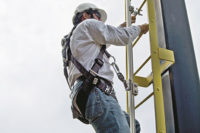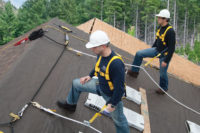In this article, you'll learn...
After more than 70 years of safety standards, rules and regulations being put in place, workers at height are still experiencing fatal falls and serious injuries. Many workers and employers misperceive fall protection equipment to be a hindrance to work activities, as well as difficult to implement and use.
Though OSHA standards have been established to assure safe working conditions for men and women, they fall short of delivering the most clear, comprehensive and up-to-date safety information. ANSI, on the other hand, creates voluntary standards that serve as more all-inclusive, easy-to-understand safety reference materials. Unfortunately, many organizations tend to overlook the importance of ANSI standards and the value of being ANSI compliant. For both OSHA and ANSI, safety and health are paramount considerations.
OSHA vs. ANSI
OSHA is a division of the United States Department of Labor that sets and enforces safety standards and provides training, outreach, education and assistance for workers in order to facilitate awareness and understanding of those standards. OSHA regulations are governing law and mandatory in nature, requiring all applicable employers and their workers to comply. Employers found to be not in compliance can face serious consequences, including citations and hefty fines.
ANSI (the American National Standards Institute) exists to promote and facilitate voluntary consensus standards that are aimed at enhancing the American quality of life and improving workers’ safety on the job. In general, ANSI standards are intended to serve as aids for manufacturers, consumers and the general public. Each standard is subject to periodic review, which is why users are cautioned to reference the latest editions and updates. However, unlike OSHA regulations, observing ANSI standards is not required by law. In other words, employers can choose to bypass ANSI standards without facing any penalties, yet they could be placing the safety of their workforce in jeopardy.
ANSI’s Z359 Fall Protection Code
As a government entity, OSHA is generally built for power, not speed, so many of its regulations are dated and vague. In fact, OSHA regulations have remained relatively unchanged since the mid-1990s, which creates a demand for more current fall protection safety information.
In 1992, ANSI released a comprehensive family of standards, collectively known as the Z359 Fall Protection Code, to help organizations and employers learn how to minimize the risk of potentially dangerous or fatal fall hazards. Like all ANSI standards, the Z359 family of standards is voluntary in the sense that its use is not mandated by law, but highly recommended and encouraged as a safe practice. Now covering a series of ten fall protection-related standards, the Z359 code addresses personal fall arrest systems, fall protection programs, anchorage connectors, self-retracting devices and more. Additional standards are continually being evaluated and added to keep the ANSI Z359 Fall Protection Code up-to-date.
Compliance requirements for the latest addition to the Z359 family — the Z359.7 standard for Qualification and Verification Testing — went into effect in October 2012. The Z359.7 standard is considered an umbrella standard, one that applies to all products within the Z359 Fall Protection Code, including full body harnesses, energy absorbing lanyards, self-retracting devices and anchorage connectors. Under Z359.7, all fall protection products must be tested in an accredited lab setting. The new standard also addresses the minimum testing and verification requirements of third-party testing labs and manufacturer testing labs as it relates to products within the Z359 Fall Protection Code.
Essentially, the new standard in the ANSI Z359 family takes the safety of fall protection products to the next level, requiring equipment to pass meticulous testing procedures before becoming certified as compliant. ANSI is widely known for having the most current, comprehensive standards that help to optimize workers’ health and safety on the job, which is why Z359.7 is so important.
What makes ANSI standards valuable?
ANSI’s safety standards are by far the most comprehensive, reliable and up-to-date, not only addressing fall protection safety, but also ladder safety, construction safety, clothing and equipment safety, workplace surfaces safety and occupational health safety. ANSI safety standards are implemented as responsible best practices that maximize worker safety and minimize the risk of serious injury or death, especially for at-height workers.
The introduction of the ANSI Z359 standards provides more guidance than any single resource for developing and implementing an effective fall protection program. Companies that choose ANSI Z359-compliant products are choosing equipment that has been proven to be the safest and the most up-to-date with the latest standards. As a result, end users gain the peace of mind and the reassurance that comes with using fall protection gear tested against the most current standards.
In a sea of safety rules and regulations, ANSI fall protection standards are the most directly relevant to workers at height. They complement OSHA regulations in seeking to maximize the safety and health of workers, and reducing risk and improving safety for workers at height, in particular. Employers of workers at height owe it to their workers to take the ANSI standards just as seriously as they do the OSHA regulations.






